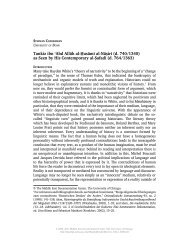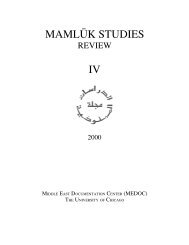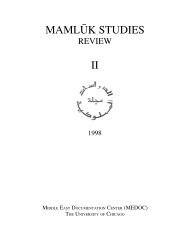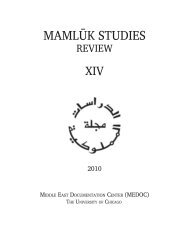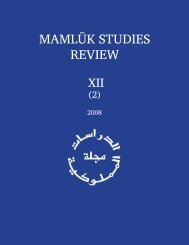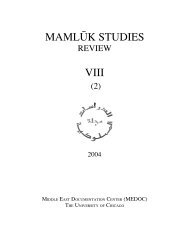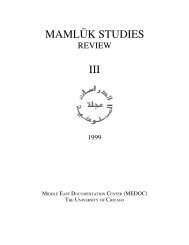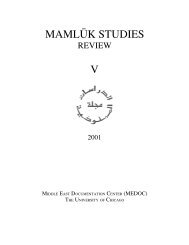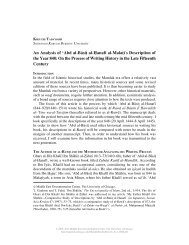Mamluk Studies Review Vol. VI (2002)
Mamluk Studies Review Vol. VI (2002)
Mamluk Studies Review Vol. VI (2002)
Create successful ePaper yourself
Turn your PDF publications into a flip-book with our unique Google optimized e-Paper software.
22 STEPHAN CONERMANN AND SUAD SAGHBINI, AWLA≠D AL-NA≠S AS FOUNDERS<br />
were free-born non-Muslims of Turko-Circassian stock outside the Islamic sphere<br />
of power, who were then enslaved, brought to Egypt, converted to Islam, trained<br />
in chivalry, and finally manumitted. Only those fulfilling these criteria could<br />
belong to the ruling class and share the resulting political, military, and economic<br />
privileges. A substitute family grouped around a specific master (usta≠dh) constituted<br />
the smallest unit within this ruling <strong>Mamluk</strong> caste. 3 It bore the name of its usta≠dh<br />
and became extinct only upon the death of its last member. <strong>Mamluk</strong> ideals called<br />
for fierce and lifelong loyalty to the master, and staunch solidarity with the comrades<br />
grouped around the same foster-father. Loyalty and solidarity lent position and<br />
social stability to the individual <strong>Mamluk</strong>. The drawback of this pronounced esprit<br />
de corps was an internal rivalry between the various <strong>Mamluk</strong> "families," a resulting<br />
general conflict within the ruling <strong>Mamluk</strong> caste, and especially the inevitable loss<br />
of power when the respective protector was overthrown or died. 4 But despite the<br />
tensions inherent in the system, the model of the <strong>Mamluk</strong> "non-hereditary onegeneration<br />
nobility" 5 actually seems to have promoted stability, perhaps in part<br />
due to its simplicity. At any rate, one can assume that the longevity of <strong>Mamluk</strong><br />
rule over the autochthonous populations of Egypt and Syria may also—perhaps<br />
even primarily—be attributed to the <strong>Mamluk</strong> principle of constant self-renewal.<br />
On the other hand, a model of society which barred its own offspring from<br />
acceding to power did not prove to be viable in the long run. Every principle is,<br />
after all, based on the idea that no, or very few, exceptions from the rule are<br />
permissible. And it is exactly here that difficulties set in. A cursory glance at the<br />
list of rulers indicates that a dynastic line of succession existed during the entire<br />
era of <strong>Mamluk</strong> rule. Whereas only seven genuine <strong>Mamluk</strong>s ruled in the years<br />
from 684/1250 until 784/1382, there were seventeen sons of <strong>Mamluk</strong> fathers. And<br />
even during the subsequent period, the Circassian era from an ethnic point of<br />
view, eight out of a total of twenty-four sultans were born in Egypt. One reason<br />
späten Mittelalter, 1250–1500," in Geschichte der arabischen Welt, ed. Ulrich Haarmann (Munich,<br />
1994), 217–63, esp. 217–36; Linda S. Northrup, "The Bah˝r| Mamlu≠k Sultanate, 1250–1390," in<br />
The Cambridge History of Egypt, vol. 1, Islamic Egypt: 640–1517, ed. Carl F. Petry (Cambridge,<br />
1998), 242–89; and Jean-Claude Garcin, "The Regime of the Circassian <strong>Mamluk</strong>s," in ibid.,<br />
290–317.<br />
3 David Ayalon, "L'esclavage du Mamelouk," Oriental Notes and <strong>Studies</strong> 1 (1951): 1–66, and<br />
idem, "The <strong>Mamluk</strong> Novice: On his Youthfulness and on his Original Religion," Revue des études<br />
islamiques 54 (1986): 1–8.<br />
4 On this, see D. S. Richards, "<strong>Mamluk</strong> Amirs and their Families and Households," in Philipp and<br />
Haarmann, <strong>Mamluk</strong>s in Egyptian Politics, 32–54, and Robert Irwin, "Factions in Medieval Egypt,"<br />
Journal of the Royal Asiatic Society (1986): 228–46.<br />
5 David Ayalon, "Names, Titles and 'Nisbas' of the <strong>Mamluk</strong>s," Israel Oriental <strong>Studies</strong> 5 (1975):<br />
193. See also idem, "<strong>Mamluk</strong> Military Aristocracy: A Non-Hereditary Nobility," Jerusalem <strong>Studies</strong><br />
in Arabic and Islam 10 (1987): 205–10.<br />
© <strong>2002</strong>, 2012 Middle East Documentation Center, The University of Chicago.<br />
http://mamluk.uchicago.edu/<strong>Mamluk</strong><strong>Studies</strong><strong>Review</strong>_<strong>VI</strong>_<strong>2002</strong>.pdf



